Travel guide to Heraklion Crete
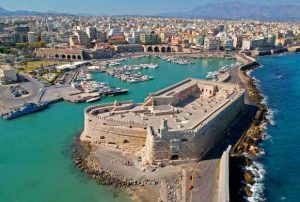 Heraklion is the capital of Crete, it has the characteristics of Athens in terms of urban planning, as a student city, however, it is full of winter-summer life and if left untouched it can take you to an incredible rhythm of fun. It is a fact that in summer you will hardly choose it as a place to stay as there are many and attractive options in tourist resorts and coastal villages.
Heraklion is the capital of Crete, it has the characteristics of Athens in terms of urban planning, as a student city, however, it is full of winter-summer life and if left untouched it can take you to an incredible rhythm of fun. It is a fact that in summer you will hardly choose it as a place to stay as there are many and attractive options in tourist resorts and coastal villages.
While in Heraklion is worth discovering the signs of the past in one of the most historic cities of the Mediterranean: the Venetian walls, the Ottoman monuments, the Loggia, the central market, the Basilica of St. Mark, the temples of St. Titus, St. Minas, St. Catherine, St. Peter and the imposing fortress of Koule. The Archaeological Museum of the city is the ark of Minoan art and one of the most important museums of prehistoric art in the world.
Heraklion today is one of the most developed, in all sectors, excellent tourism infrastructure, large hospitals, University and Technical faculties of various specialties, as well as one of the largest research centers in the country, the Institute of Technology and Research
Your image of the Minoan civilization will of course be completed with a visit to Knossos, Phaistos and Archanes. The great advantage offered by the area of Heraklion is that it can cover any type of traveler. In Hersonissos and Malia you will enjoy the intense nightlife with young European tourists but also a quiet vacation in one of the big resorts.
The same in Agia Pelagia, which families choose as a place of residence enjoying the all inclusive packages. If you are still looking for the travel experience, from nature hiking to walks in unruly villages, you should explore the area under the shadow of Asterousia and the root of Psiloritis.
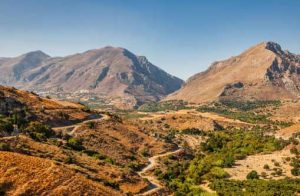 The prefecture of Heraklion is suitable for mountaineering and hiking as it has many seductive natural sites for exploration, impressive caves and unique routes through beautiful landscapes made from the colors of nature and the passage of time.
The prefecture of Heraklion is suitable for mountaineering and hiking as it has many seductive natural sites for exploration, impressive caves and unique routes through beautiful landscapes made from the colors of nature and the passage of time.
The variety of the landscape is reflected in the beaches of the prefecture, satisfying the tastes of every visitor. You can find organized, touristy, large beaches with golden beaches or picturesque bays with steep rocky shores, all with their common element the crystal clear waters. Some of the most popular beaches are Agia Pelagia, Ammoudara, Gouves, Kalamaki, Matala, Paleokastro, Keratokampos, Loutra, Kommos, Kaloi Limenes, Tympakia etc.
Despite the great reconstruction of the last decades, the city of Heraklion managed to maintain its Venetian nobility that distinguished it during the Venetian period. Remarkable buildings and squares of the area such as Eleftherias Square, the Lions, the Bebo fountain, the Venetian fortress at the entrance of the port, the Archaeological and Historical Museum of Crete and many monasteries and basilicas reflect glorious historical times causing the admiration of every traveler.
The first impression of the visitor when he arrives in Heraklion is a bit disappointing as he encounters a noisy big city whose appearance does not resemble anything from an island. However, the phenomena deceive when, afterwards, he discovers the beauties and the charm that this unique region of Crete hides.
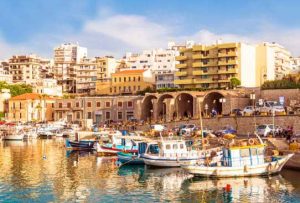 Heraklion consists of the Old and the New Town. Nea Poli has been the capital of the prefecture since 1972, an important financial center which contributes significantly to the trade and industry of Crete.
Heraklion consists of the Old and the New Town. Nea Poli has been the capital of the prefecture since 1972, an important financial center which contributes significantly to the trade and industry of Crete.
The part of the Old Town is located between the old walls forming a triangle whose base overlooks the sea and its top meets the Martinengo bastion at the highest point of which is the tomb of the famous writer Nikos Kazantzakis.
The picturesque Venetian port of Heraklion is ideal for endless morning or evening walks and is an ideal place to enjoy the wonderful view around the castle walls.
A short distance from the Venetian port is the Historical Museum of Heraklion which was founded in 1952 by the Research Institute of the History of Crete. The museum houses many important exhibits and archaeological finds which depict various forms of Cretan life starting from the beginning of the Christian period.
Those who visit Heraklion have the opportunity to wander the streets of the Old Town and visit some of the “hidden ornaments” of the area such as the picturesque square of Eleftherios Venizelos full of cafes, restaurants and tourist shops, and the Morozini Fountain in the center. square, known as “the Fountain of the Lions”, which was built in 1628 by the then Governor of Crete Frazesco Morosini.
Apart from the Old and New Towns of Heraklion, in the prefecture there are many beautiful areas to visit. As you go south of the prefecture of Heraklion you will encounter enchanting beaches with crystal clear waters as well as hospitable and very friendly inhabitants.
One of the most interesting sights of the area is the famous Aquarium of Crete which is located between the city of Heraklion and the tourist resort of Hersonissos. It is home to 2500 living marine organisms such as many varieties of fish, sharks, shellfish, jellyfish and other beautiful species of seabed. The Aquarium is open to the public daily all year round and receives thousands of visitors of all ages.
The prefecture of Heraklion, starting from the coastal cosmopolitan resort of Hersonissos and reaching the archeological sites of Archanes and Pyrgos, is one of the most remarkable destinations in Crete that should not be missed.
HISTORY
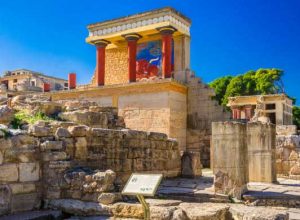 The history of Heraklion begins thousands of years behind the era of mythology. The prefecture of Heraklion hosts the famous Minoan palace of Knossos, known for the history of Theseus and the Minotaur.
The history of Heraklion begins thousands of years behind the era of mythology. The prefecture of Heraklion hosts the famous Minoan palace of Knossos, known for the history of Theseus and the Minotaur.
The palace of Knossos is one of the most important historical attractions of Crete, which is why it receives a large number of visitors every year.
During the Minoan era, Heraklion marked its greatest prosperity, being the most important cultural center of Crete. In the area there are remarkable archeological sites such as Knossos, the largest and most important palace of Minoan Crete, Phaistos and Malia, which gather the greatest tourist interest.
References to Heraklion have been made by ancient historians, such as Strabo, who in his texts in the 1st AD. century refers to the port of Knossos as Heraklion, apparently named so in honor of Hercules, who came to Crete to kill the wild bull and complete the seventh of his twelve feats.
During the 9th AD. century the Arabs conquered Crete and founded in the place of Heraklion a new city called Rabdh al Khandak (Castle of the ditch). The name Chandakas is still used by many residents of the city of Heraklion.
In the 10th century the Byzantines regained control of the island and managed to control it until the beginning of the 13th century.
During the 14th century, the city fell to the Venetians. The Venetian period lasted four and a half centuries and was the period of great progress for the city in terms of development in areas such as trade, architecture, literature and art in general.
The world-famous painter Domenikos Theotokopoulos (El Greco) was born in Heraklion where he initially worked. Many Venetian monuments still exist in Heraklion, such as the old walls that surround the old part of the city.
After the siege of the city of Heraklion by the Turks (which began in 1648 and lasted for 25 years) the Venetians were forced to hand over the city to the Turks.
The Cretans rebelled against the Ottoman Turks many times, such as in 1770, 1821, 1866 and 1895. In 1898 the island of Crete regained its autonomy from the Ottoman Empire and in 1912 united with Greece.
WHAT TO SEE
Knossos
The palace of Minos that was built around 1900 BC. was the largest center of Minoan civilization. The visit to Knossos naturally starts from the palace (from the royal apartments, the treasuries and the throne room to the customs in the north wing and the south Propylos).
However, there are monuments outside the Palace, the Small Palace, the Royal Villa, the House of Murals, the Royal Tomb etc. The archeological site is located about 10 km south of the city of Heraklion and is open to the public daily, from 8 a.m. until 5 pm, except holidays. The ticket is € 6, but you can get the common ticket for Knossos and the Archaeological Museum of Heraklion, which costs € 10.
Phaistos
Built between Psiloritis, the Asterousia Mountains and the Lassithi Mountains, it was the second most important center of Minoan civilization. It began to be inhabited from the Neolithic era and flourished in the middle of the 3rd millennium BC, the Bronze Age. One of the most important findings of the excavations which is kept in the Archaeological Museum of Heraklion is the famous Disk of Phaistos which probably dates back to the 17th century BC. and has not been fully decrypted.
Gortyna
It is located in the plain of Messara, where it is believed that the first people lived in Crete somewhere in the late Neolithic period, and is 45 km from the city of Heraklion. It seems to have been inhabited around 3000 BC. and flourished during the Minoan period, from 1600 BC. until 1100 BC Unfortunately, only a small part of the city has been excavated, while in the visitable part one of the most interesting finds is the early Christian church of Agios Titos, of the 6th century AD.
Archaeological site of Archanes
South of Knossos, the Minoan city of Archanes was one of the most important in Crete, from the late Neolithic period to historical times. The largest cemetery in the Aegean from prehistoric times has been found at the Fourni archeological site, northwest of Archanes.
At 4 km south of Archanes, in the area of Piso Livadia, is Vathipetro, a Minoan palace with central and western courtyard, with outdoor areas, storage and galleries.
In fact, in one of its wings, a grape press was discovered and in its yard, an olive mill installation. It is no coincidence that from antiquity until today, Archanes is considered one of the most important areas for viticulture and olive oil production.
Koule
The two-storey Venetian Fortress (Rossa a Mare or Castello a Mare) was built between 1523 and 1540 at the entrance of the port to protect the city from attacks. During the Turkish siege (1646-1669) some of its premises were turned into prisons.
The fortifications of the fortress have been restored, while on the northeastern, western and southern sides, the marble reliefs of the winged lion of Venice are preserved, mutilated. Today some parts of the fortress are used for artistic events, exhibitions, performances and concerts. At the pier of the port, just behind the wall, there is a pedestrian street that is suitable for walks.
Venetian walls
The imposing wall of the Venetian period is 3 km long, began to be built in 1426 and is the largest fortification project in the Mediterranean. It has four gates (of Molos, of St. George or Lazarus, of Jesus and the Pantocrator) and seven bastions (Sabbionera, Vitturi, Jesus, Martinengo, Bethlehem, Pantocrator and St. Andrew). The tour usually starts from the bastion of Agios Andreas on Ethnarchou Makariou Street. In the Martinengo tower, in the southern part of the wall, is the tomb of Nikos Kazantzakis, which has the phrase “I hope for nothing” engraved on it. I’m not afraid of anything. I am free”.
Cretaquarium – Sea World
In the 32 tanks with a total capacity of 1,600,000 liters of the largest aquarium in the country, habitats have been created where 2,500 organisms from 200 species are hosted. You will see from large mammals to tiny seahorses. In front of each tank there are memos but the navigation becomes more vivid with the help of audiovisual systems. It is housed in the old American Gournes Base.
Archaeological Museum of Heraklion
One of the most important museums in Greece, with an extremely large and rich collection that includes Minoan treasures from all over the island.
In the rooms that are shared on two floors you will see statuettes, weapons, jewelry, tools, murals, all symbols of the golden age of Knossos, the famous Bee Jewel from the palace of Malia, the Disk of Phaistos, the fresco of white lilies Lilies mansion in Amnisos and many more finds. In Eleftherias Square, above the Venetian port.
Saint Titus
The church was built in 961, when Byzantium recaptured Crete from the Arabs. During the surrender of Chandakas to the Ottomans in 1669, all the relics were transported to Venice. Later, the great earthquake of 1856 destroyed it and the church was rebuilt according to the plans of the architect Ath. Mousis. Here is kept the Chariot of St. Titus that was transported by St. Mark of Venice.
Basilica of St. Mark
On the pedestrian street of the 25th of August in the center of the city is the metropolitan church of St. Mark of the Venetians, which today houses the Municipal Gallery. At the time of Venetian rule, all lords and officials here officially took up their duties.
Saint Matthew
It houses a rare collection of icons, which includes important works of the Cretan School, such as “The Crucifixion” by Georgios Kastrofylakas (1752), “Saint Titus and scenes from the life of the ten martyrs” by Ioannis Kornaros (1773) but also two unsigned icons of Michael Damaskinos. It was built in the NW Byzantine period and you will find it near the square of Agios Minas (Taxiarchos Markopoulos).
Paliani Monastery
At an altitude of 280 m. Next to the village of Venerato (20 km north of Heraklion) is one of the oldest monasteries on the island (6th century). Its main church is a three-aisled basilica and behind the church is a 1,800 year old myrtle that the legend wants to be associated with the icon of the Virgin. The monastery has a museum with icons, sacred relics and various books of great historical value.
“Labyrinth” music workshop
In the summer evenings you will see in the square of the village Houdetsi groups playing music and singing. Most people come here to take part in workshops organized by Ross Daly with the participation of artists from all over the world and the rest to admire the wonderful collection of musical instruments from Greece and the Balkans to Turkey and Persia.
Lychnostatis Museum
Made with the taste of an individual, it is a place of promotion of the popular culture of Crete. Through the representation of a traditional Cretan village the visitor collects information about the folklore, the old professions, the self-taught folk artists and even about the flora of the place. In the cafe of the museum you can try herbal teas of Crete. (Hersonissos Port, Plaka Place)
Panagia Gouverniotissa
In Potamies Hersonissos, in a green landscape with a wonderful view, is the church of an old monastery of the Venetian period, with frescoes dating to the second half of the 14th century. Made according to the artistic standards of Constantinople, they classify the church of Gouverniotissa among the most important monuments of the Paleolithic period in Crete.
Historical Museum of Crete
Modernized with audiovisual media and very interesting, it hides the history of the island from the early Christian centuries to the modern era. One of the most impressive exhibits is the model of the city of Chandakas of the 17th century. and the paintings of Dominikos Theotokopoulos.
Museum of the Battle of Crete and the National Resistance
Bibliographic documents, photographs and war objects, monographs, studies of historical events from 1941 to 1945, documents and publications compose a rich history of the resistance of the Cretan people during World War II.
Nikos Kazantzakis Museum
The village of Myrtia (15 km from Heraklion) is the place of origin of Nikos Kazantzakis and there the set designer Nikos Anemogiannis created a museum with personal objects of the great Greek writer, material from theatrical performances of his works etc.
Museum of Saint Catherine of Sinai
Next to the Metropolitan Church of Agios Minas, the church of Agia Aikaterini is one of the best preserved examples of urban architecture of the Venetian occupation. Today it functions as a museum and houses an exhibition of the Holy Archdiocese of Crete with representative works of the Cretan Renaissance. A special place is occupied by the portable icons of Michael Damaskinos, the most important painter of the Cretan School.
Museum of Cretan Ethnology
At a distance of 2 km from the Minoan palace of Phaistos, in the traditional settlement of Voroi, it hosts objects of traditional everyday life from all over Crete and has a research institute that studies social processes in Megalonisos, from the Middle Ages until today. Launched in 1988 and awarded in 1992 by the Council of Europe.
Hodegetria Monastery
In the arms of Asterousia, at an altitude of 250 meters, it was founded in the 14th century. from the Kallergis family. It is considered one of the oldest monasteries in Crete. It has a fortress architecture – today parts of the wall are preserved, the north gate, with the relief dated 1568, and the tall Tower of Xopatera.
Monastery Vrontisiou
For the monastery located between the villages of Zaros and Vorizia at a distance of 50 km from Heraklion there are written testimonies from 1400, while from 1500 it seems that it experienced its prosperity. It was one of the most important centers of monasticism in Crete, where letters and arts flourished, especially painting. Despite the damage it has suffered, it remains one of the most beautiful and imposing monasteries, with amazing views of the Messara plain and the Libyan Sea.
Monastery of Koudouma
It is the only monastery in Crete that is built on a beach. It is located about 80 km south of Heraklion – the last 24 km is a passable dirt road that starts from the village of Sternes. The male monastery is dedicated to the Assumption of the Virgin Mary and the sanctuary is located inside a small cave. If you get here, it is worth walking 15-25 minutes west to Abakkospilios with stalactites and stalagmites. Hiking enthusiasts follow a longer route lasting 45 minutes to the cave of Agios Antonios with the homonymous church.
Heraklion beaches
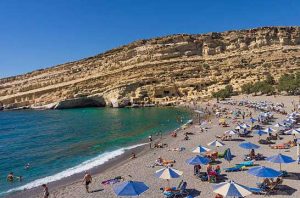 Most beaches have easy access and in the whole prefecture of Heraklion there are several that are organized. You may not be able to swim in Hersonissos when it is north, but when the weather allows it, the beach is full of people and shaken by the music of the beach bars. To the west, in Limanakia, you will find small, sandy beaches with less people.
Most beaches have easy access and in the whole prefecture of Heraklion there are several that are organized. You may not be able to swim in Hersonissos when it is north, but when the weather allows it, the beach is full of people and shaken by the music of the beach bars. To the west, in Limanakia, you will find small, sandy beaches with less people.
The large sandy beach of Malia, which starts from the settlement of Stalis, is also very busy and well organized. In recent years, the bay of Agia Pelagia with the organized beach, which is always protected from the north winds, and the organized diving centers is also rising.
Near Agia Pelagia, Psaromoura beach gathers several families, Mononafti beach is quieter and has fine sand, as does Lygaria, but to get there you have to walk some distance.
Ammoudara stretches for 5 km and has a windsurfing school. The youth of Heraklion, however, vote for Kartero for the big beach bars and the beach Arina which is full of umbrellas and beach bars, while it has many options for beach sports.
In the south of the island, the golden blonde beach of Matala is one of the busiest, but near it is the quieter Kokkini Ammos which you can reach by boat or 20 minutes walk.
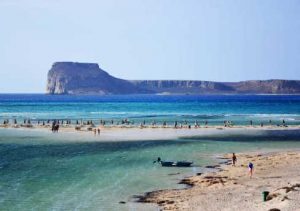 The small fishing village of Kalamaki, about 2 km from Matala, has a long sandy beach, taverns, cafes and rooms for rent and families choose it, while Komos between Matala and Kalamaki with its gray sand is a huge northern beach that in one part it is absolutely calm, while in other places it is full of wicker umbrellas and sunbeds.
The small fishing village of Kalamaki, about 2 km from Matala, has a long sandy beach, taverns, cafes and rooms for rent and families choose it, while Komos between Matala and Kalamaki with its gray sand is a huge northern beach that in one part it is absolutely calm, while in other places it is full of wicker umbrellas and sunbeds.
Organized with a cafe and restaurant is the Red Tower that starts from the homonymous settlement and reaches the airport of Tympaki.
In Kalous Limenes, it is worth the beautiful beach of Chrysostomos, where the ancient Lasaia was located and traces of its port can be seen at the point between the rocks and the small island opposite.
A few kilometers east you will find Platia Peramata beach, with coarse sand and tamarisk trees and the organized sandy beach of Lentas.
At 1 km, the beach Dytiko or Disko, with tamarisk trees and thick pebbles, used to be preferred by free campers. East of Lenta there are many small and inaccessible beaches.
One of the most beautiful is the isolated beach of Trafoulas or Psili Ammos with sand and pebbles. It can be reached either on foot or by sea by boat from Lentas.
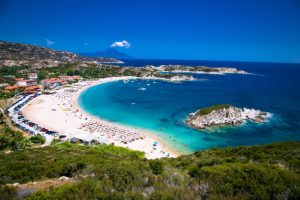 The sandy beach of Tsoutsoura bay is also beautiful, the beach gathers a lot of people, however, those who are looking for isolation follow with the car the dirt road (for 15 km) to reach Maridaki. From a dirt road that leaves the port of Lentas and heads east, to Kroto you can reach Tripiti beach, which is located at the exit of the gorge of the same name.
The sandy beach of Tsoutsoura bay is also beautiful, the beach gathers a lot of people, however, those who are looking for isolation follow with the car the dirt road (for 15 km) to reach Maridaki. From a dirt road that leaves the port of Lentas and heads east, to Kroto you can reach Tripiti beach, which is located at the exit of the gorge of the same name.
There is another route to get here: it starts from the village of Vasiliki of Messara, which you go through the village of Agioi Deka, and it is worth it because it crosses the wild Asterousia Mountains.
Some other options for swimming overlooking the Libyan Sea are Keratokambos, Psari Forada, Tertsa. If you are in the mood for discoveries, it is worth swimming in the beach where the Agiofarago ends after a 15-minute walk in the gorge, but also in the pebble beach of Koudoumas.
Vathi with its green-blue waters is also wonderful, only to get here you have to follow a dirt road 9 km from the Monastery of Odigitria or come by boat from Agia Galini, Malia or the Red Tower.
DAY TRIPS
Rouva Forest
It is located in the southeastern part of the Psiloritis mountain range and is the most important of the natural forest ecosystems that have remained in the Prefecture of Heraklion. It is part of the Natura 2000 program and has the largest cluster in Europe. Here you can observe many endemic plants, among them the endangered Cretan orchid (Cephalanhera cucullata). If you want to learn more about the habitat visit the Museum of Local Natural History in Gergeri.
Agia Pelagia
A small church gave its name to the area located 18 km west of Heraklion and has in recent years become one of the most tourist centers of the prefecture with large hotels, luxury lifestyle resorts, restaurants and nightclubs around the closed, sheltered from the meltemia bay.
Fodele
At a distance of 30 km west of Heraklion, the beautiful beach, the tourist infrastructure and his relationship with Dominikos Theotokopoulos have made Fodele a pole of interest for Greek and foreign tourists. There are many Cretans who claim that the green village is the birthplace of the great painter, the world-famous El Greco, but there is disagreement on this issue. At the Dominikos Theotokopoulos Museum, however, you will see exact copies of the painter’s works and a small workshop with drafts and old photographs of the restored house where the museum is housed. It is also worth visiting the Byzantine basilica of Panagia and taking a walk along the Pandomandris river among the trees.
Archanes
The traditional settlement with the restored houses has been awarded in a competition of the European Union and is an example of the way in which its residential development has been done.
It has winter life and summer and both in the town and in the wider area you will find good accommodation solutions.
It is worth a visit to the Archaeological Museum of Archanes, with archeological findings that came to light from the excavations in the area, and just outside Archanes (3 km) to the private Museum of Cretan History and Tradition to see objects from history and tradition of the place from the 9th century until today.
Smari
Preserved traditional settlement with many restored stone houses and an acropolis, which is the most important archaeological site in the wider area of the municipality of Kasteli and overlooks the village and the olive groves
Lake Zaros
Zaros at the foot of Psiloritis is famous for its springs and since 1988 a table water bottling plant has been operating there. Near the homonymous artificial lake, which is surrounded by trees, there are two trout fish farms. Next to the refreshment room located on the lake and offered for coffee and food begins a path that leads to the impressive gorge of Agios Nikolaos Rouvas. After about 3 km the gorge ends in the amazing forest of Rouvas.
Agiofarago
The magnificent gorge, south of the prefecture of Heraklion near Matala, took its name from the 300 hermits who practiced there in the past. It is said that they lived in conditions of complete isolation and met only once a year in a large cave, the “Goumenospilio”.
You will see it if you make the ninety minute walk through the gorge as well as the church of Agios Antonios (14th century). The hike ends at an incredible pebble beach. There are several ways to reach Agiofarago: by boat from Kokkino Pyrgos, Agia Galini or Kalous Limenes and by car from the traditional village of Siva near Phaistos.
